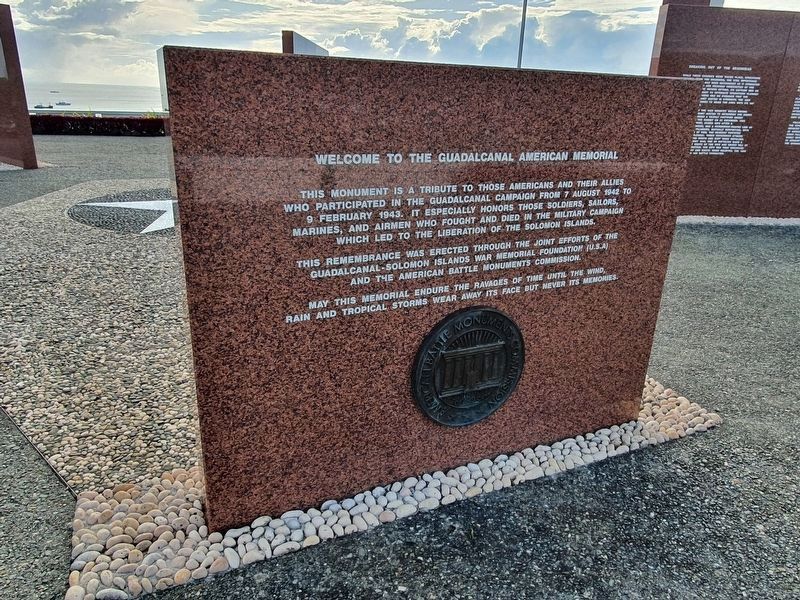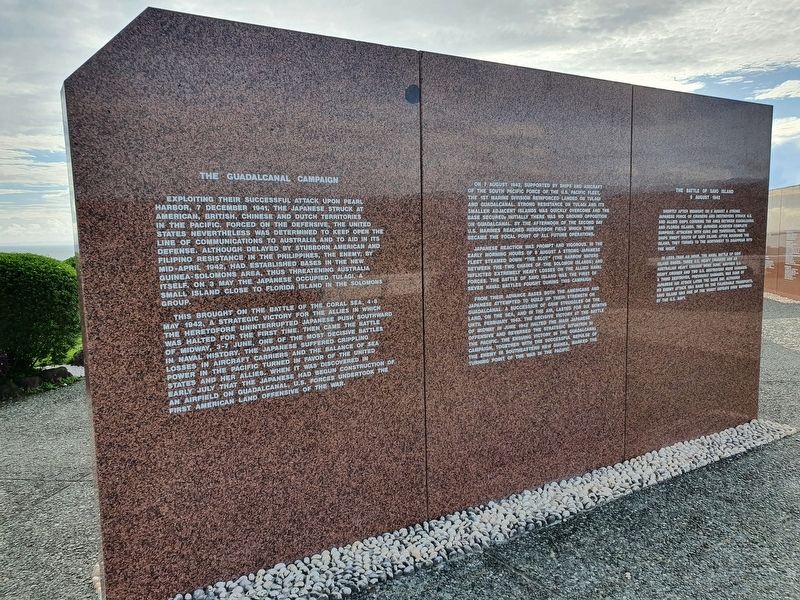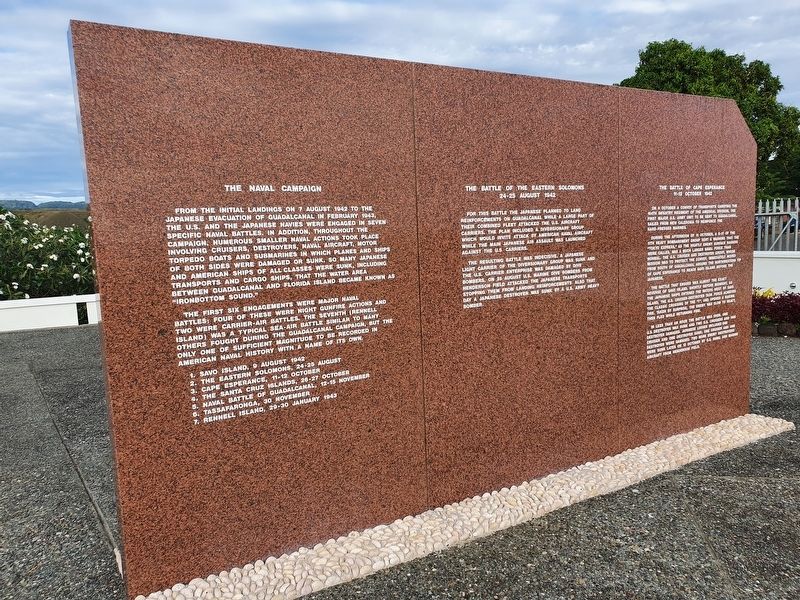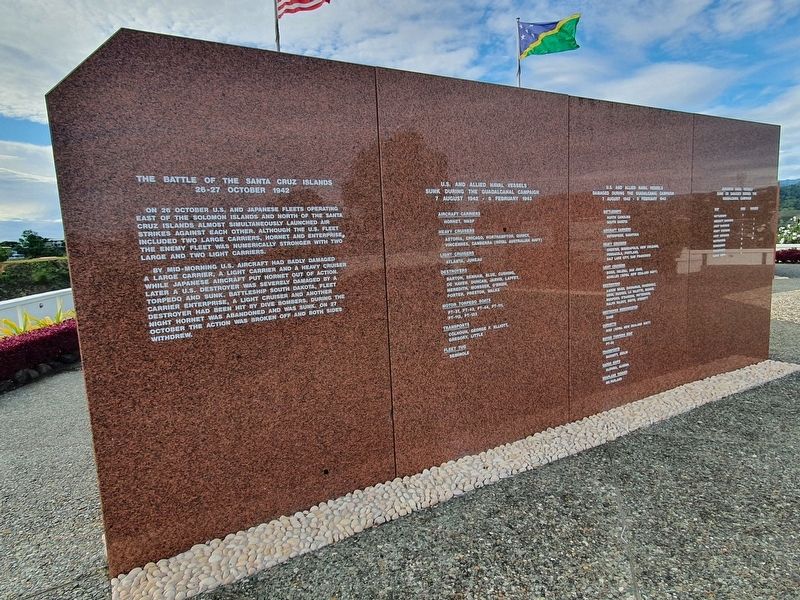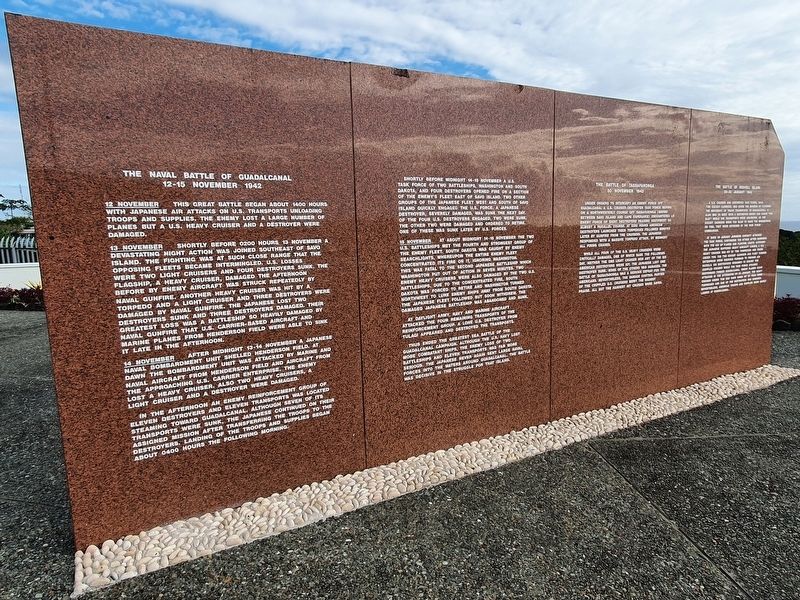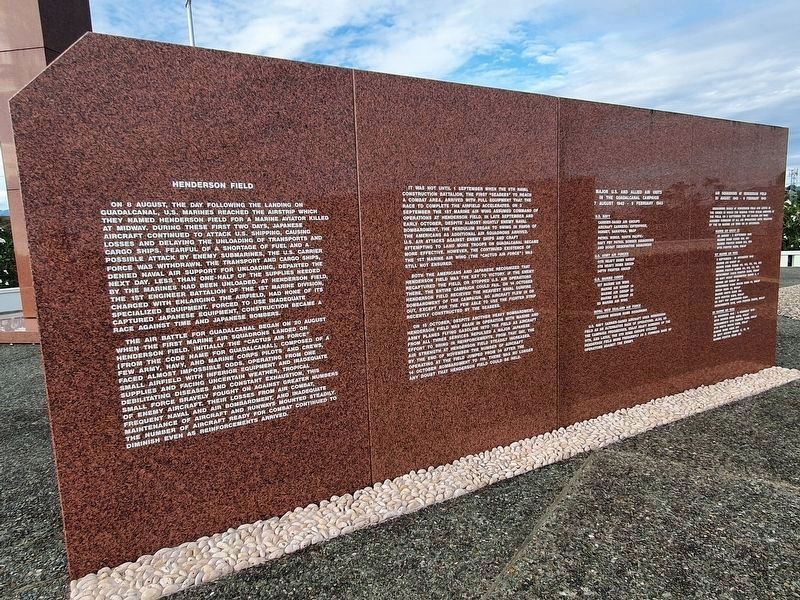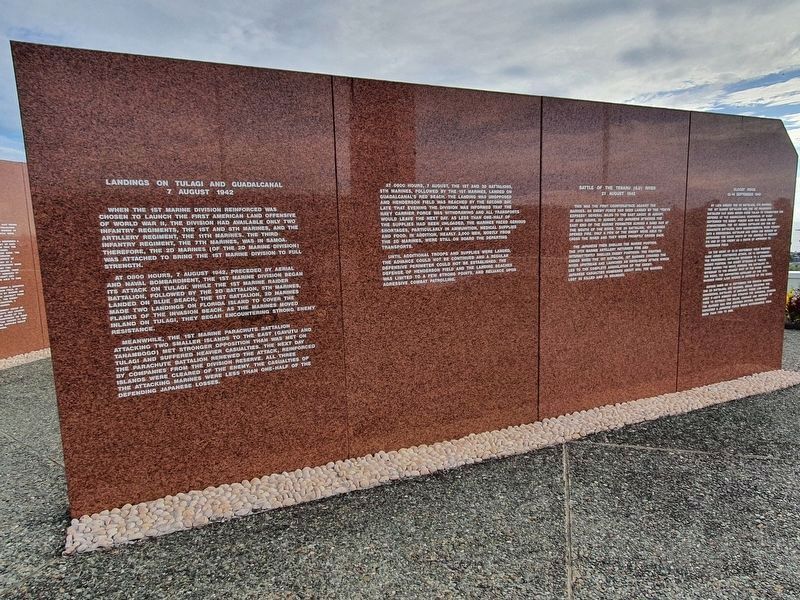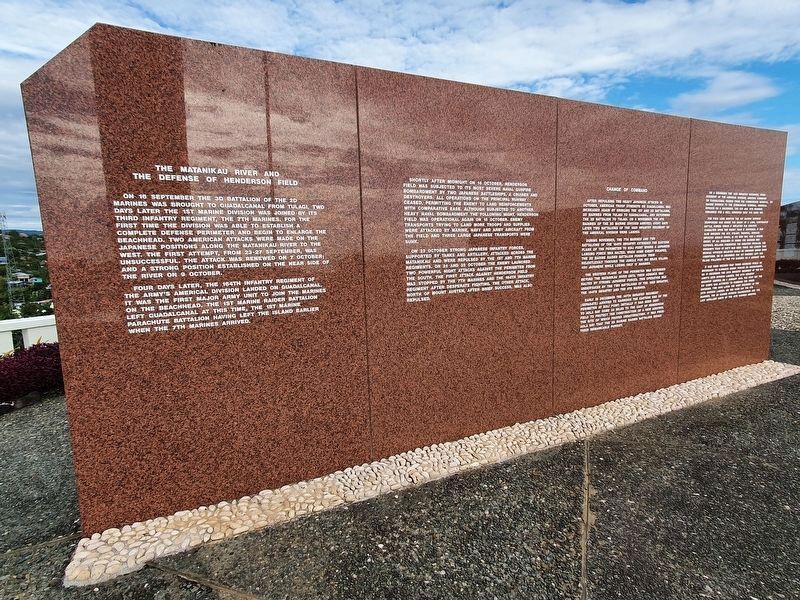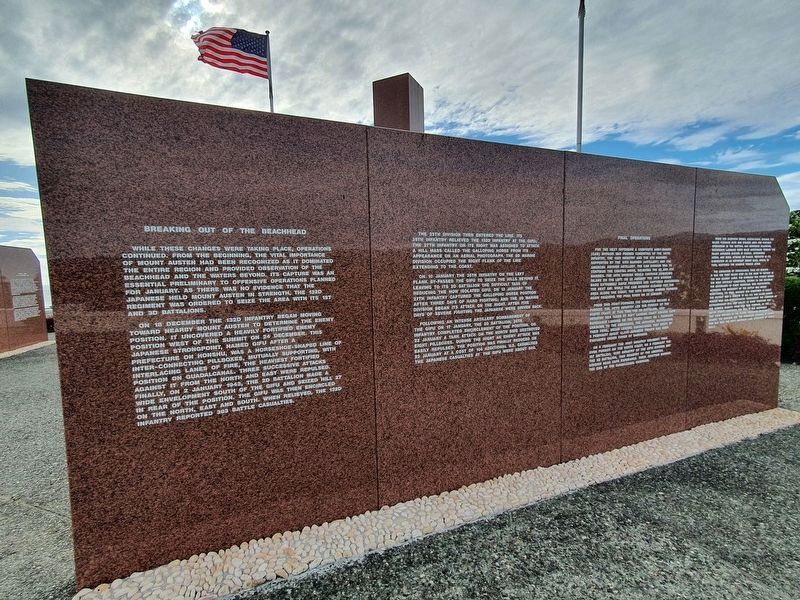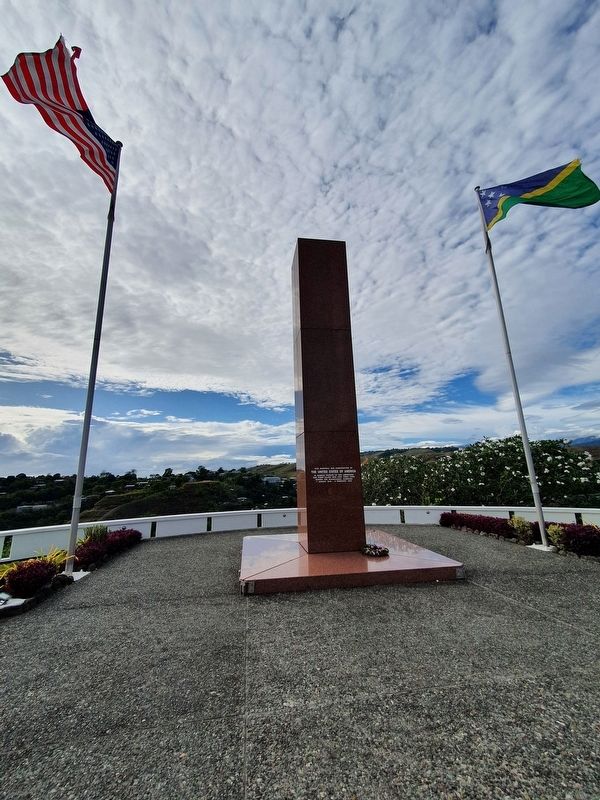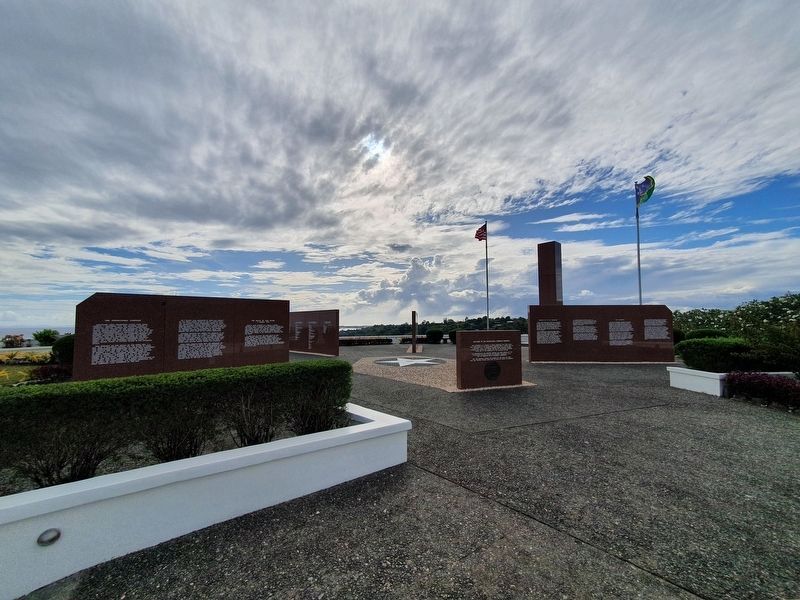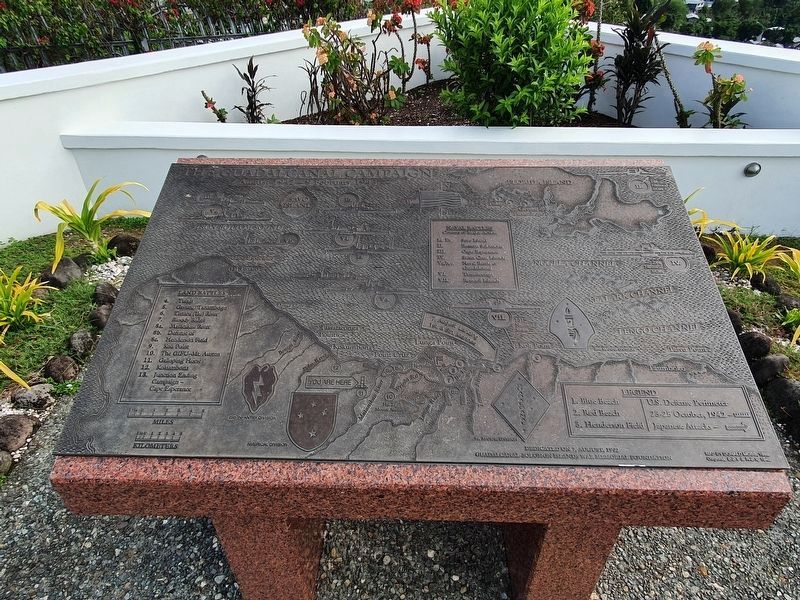Honiara in Capital Territory, Guadalcanal, Solomon Islands — Oceania (Melanesia in the Pacific Ocean)
Guadalcanal American Memorial
Welcome to the Guadalcanal American Memorial
This monument is a tribute to those Americans and their Allies who participated in the Guadalcanal Campaign from 7 August 1942 to 9 February 1943. It especially honors those soldiers, sailors, marines, and airmen who fought and died in the military campaign which led to the liberation of the Solomon Islands.
This remembrance was erected through the joint efforts of the Guadalcanal-Solomon Islands War Memorial Foundation (U.S.A.) and the American Battle Monuments Commission.
May this memorial endure the ravages of time until the wind, rain and tropical storms wear away its face but never its memories.
One
The Guadalcanal Campaign
Exploiting their successful attack upon Pearl Harbor, 7 December 1941, the Japanese struck at American, British, Chinese and Dutch territories in the Pacific, forced on the defensive, the United States nevertheless was determined to keep open the line of communications to Australia and to aid in its defense. Although delayed by stubborn American and Filipino resistance in the Philippines, the enemy, by mid-April 1942, had established bases in the New Guinea - Solomons area, thus threatening Australia itself. On 3 May the Japanese occupied Tulagi, a small island close to Florida Island in the Solomons group.
This brought on the Battle of the Coral Sea, 4-8 May 1942, a strategic victory for the Allies in which the heretofore uninterrupted Japanese push southward was halted for the first time. Then came the Battle of Midway, 3-7 June, one of the most decisive battles in naval history, the Japanese suffered crippling losses in aircraft carriers and the balance of sea power in the Pacific turned in favor of the United States and her Allies. When it was discovered in early July that the Japanese had begun construction of an airfield on Guadalcanal, U.S. forces undertook the first American land offensive of the war.
On 7 August 1942, supported by ships and aircraft of the South Pacific Force of the U.S. Pacific Fleet, the 1st Marine Division reinforced landed on Tulagi and Guadalcanal. Strong resistance on Tulagi and its smaller adjacent islands was quickly overcome and the base secured, initially there was no ground opposition on Guadalcanal, by the afternoon of the second day U.S. Marines reached Henderson Field which then became the focal point of all future operations.
From their advance bases both the Americans and Japanese attempted to build up their strength on Guadalcanal. A succession of grim struggles on the land, on the sea, and in the air, lasted for six months until February 1943. The decisive victory at the Battle of Midway in June 1942 halted the main Japanese offensive and reversed the strategic situation in the Pacific. The ensuing victory in the Guadalcanal campaign, together with the successful repulse of the enemy in southeastern New Guinea, marked the turning point of the war in the Pacific.
The Battle of Savo Island
9 August 1942
Shortly after midnight on 9 August a strong Japanese force of cruisers and destroyers struck U.S. and Allied ships covering the area between Guadalcanal and Florida Islands. The Japanese achieved complete surprise. Attacking with guns and torpedoes, their ships swept south of Savo Island. After rounding the Island, they turned to the northwest to disappear into the night.
In less than an hour, the naval Battle of Savo Island ended. Three U.S. heavy cruisers and an Australian heavy cruiser were sunk. Another U.S. heavy cruiser and two U.S. destroyers were damaged. A third destroyer, previously damaged, was sunk by Japanese air attack later the same day. Although no enemy attack was made on the vulnerable transports, Savo Island was one of the worst defeats ever suffered by the U.S. Navy.
Two
The Naval Campaign
From the initial landings on 7 August 1942 to the Japanese evacuation of Guadalcanal in February 1943, the U.S. and the Japanese navies were engaged in seven specific naval battles. In addition, throughout the campaign, numerous smaller naval actions took place involving cruisers, destroyers, naval aircraft, motor torpedo boats and submarines in which planes and ships of both sides were damaged or sunk. So many Japanese and American ships of all classes were sunk, including transports and cargo ships, that the water area between Guadalcanal and Florida Island became known as "Ironbottom Sound."
The first six engagements were major naval battles: four of these were night gunfire actions and two were carrier-air battles. The seventh (Rennell Island) was a typical sea-air battle similar to many others fought during the Guadalcanal Campaign, but the only one of sufficient magnitude to be recorded in American Naval history with a name of its own.
1. Savo Island, 9 August 1942
2. The Eastern Solomons, 24-25 August
3. Cape Esperance, 11-12 October
4. The Santa Cruz Islands, 26-27 October
5. Naval Battle of Guadalcanal, 12-15 November
6. Tassafaronga, 30 November
7. Rennell Island, 29-30 January 1943
The Battle of the Eastern Solomons
24-25 August 1942
For this battle the Japanese planned to land reinforcements on Guadalcanal while a large part of their combined fleet attacked the U.S. aircraft carriers. The plan included a diversionary group which would invite attack by American naval aircraft while the main Japanese air assault was launched against the U.S. carriers.
The resulting battle was indecisive. A Japanese light carrier of the diversionary group was sunk and the U.S. carrier Enterprise was damaged by dive bombers. On 25 August U.S. Marine dive bombers from Henderson Field attacked the Japanese transports stopping them from landing reinforcements. Also that day a Japanese destroyer was sunk by a U.S. Army heavy bomber.
The Battle of Cape Esperance
11-12 October 1942
On 9 October a convoy of transports carrying the 164th Infantry Regiment of the Americal division, the first major U.S. Army unit to be sent to Guadalcanal, sailed from New Caledonia to reinforce the hard-pressed Marines.
During the afternoon of 11 October, a B-17 of the 11th Heavy Bombardment Group sent a warning that the "Tokyo Express," as the nightly enemy surface raiders were called, was a much larger naval force than normal. The U.S. cruiser and destroyer group, whose mission was to protect the convoy, immediately moved from south of Guadalcanal around the northwestern tip of Eape Esperance to reach Savo Island before the Japanese.
The battle that ensued was almost the exact reverse of Savo Island, shortly before midnight, as the Japanese ships entered the waters west of Savo Island, the U.S. cruiser-destroyer task force achieved the classic crossing of the "t" and opened a raking fire. Taken by surprise, the enemy was slow to react then fled while returning fire.
In less than an hour the battle was over. One U.S. destroyer was sunk and two U.S. cruisers and one destroyer damaged. Japanese losses included one cruiser and one destroyer sunk; one cruiser and one destroyer were damaged. Two more enemy destroyers were sunk later on 12 October by U.S. Naval and Marine aircraft from Henderson Field.
Three
The Battle of the Santa Cruz Islands
26-27 October 1942
On 26 October U.S. and Japanese fleets operating east of the Solomon Islands and north of the Santa Cruz Islands almost simultaneously launched air strikes against each other. Although the U.S. fleet included two large carriers, Hornet and Enterprise, the enemy fleet was numerically stronger with two large and two light carriers.
By mid-morning U.S. aircraft had badly damaged large carrier, a light carrier and a heavy cruiser while Japanese aircraft put Hornet out of action. Later a U.S. destroyer was severely damaged by a torpedo and sunk. Battleship South Dakota, Fleet Carrier Enterprise, a light cruiser and another destroyer had been hit by dive bombers. During the night Hornet was abandoned and was sunk on 27 october the action was broken off and both sides withdrew.
U.S. and Allied Naval vessels sunk during the Guadalcanal Campaign
7 August 1942 9 february 1943
Aircraft Carriers
Hornet, Wasp
Heavy Cruisers
Astoria, Chicago, Northampton, Quincy, Vincennes, Canberra (Royal Australian Navy)
Light Cruisers
Atlanta, Juneau
Destroyers
Barton, Benham, Blue, Cushing, De Haven, Duncan, Jarvis, Laffey, Meredith, Monssen, O'Brien, Porter, Preston, Walke
Motor Torpedo Boats
PT-37, PT-43, PT-44, PT-111, PT-112, PT-123
Transports
Colhoun, George F. Elliott, Gregory, Little
Fleet Tug
Seminole
U.S. and Allied Naval vessels damaged during the Guadalcanal Campaign
7 August 1942
Battleships
North Carolina
South Dakota
Aircraft Carriers
Enterprise, Saratoga
Heavy Cruisers
9 February 1943
Chester, Minneapolis, New Orleans, Pensacola, Portland, Salt Lake City, San Francisco
Light Cruisers
Boise, Helena, San Juan, Achilles (Royal New Zealand Navy)
Destroyers
Aaron Ward, Buchanan, Farenholt, Gwin, Hughes, La Valette, Mahan, Mugford, O'bannon, Patterson, Ralph Talbot, Smith, Sterett
Destroyer Minesweeper
Zane
Corvette
Kiwi (Royal New Zealand Navy)
Motor Torpedo Boat
PT-59
Transports
Barnett, Zeilin
Cargo Ships
Alchiba, Alhena
Seaplane Tender
McFarland
Japanese Naval vessels sunk or damaged during the Guadalcanal Campaign
Ship Sunk Damaged
Battleships 2 -
Aircraft carriers - 1
Light carriers 1 1
Heavy cruisers 3 5
Light cruisers 1 2
Destroyers 11 20
Submarines 6 -
Transports 13 -
Cargo ships 5 -
Four
The Naval Battle of Guadalcanal
12-15 November 1942
12 November This great battle began about 1400 hours with Japanese air attacks on U.S. transports unloading troops and supplies. The enemy lost a large number of planes but a U.S. heavy cruiser and a destroyer were damaged.
13 November Shortly before 0200 hours 13 November a devastating night action was joined southeast of Savo Island. The fighting was at such close range that the opposing fleets became intermingled. U.S. losses were two light cruisers and four destroyers sunk.The flagship, a heavy cruiser, damaged the afternoon before by enemy aircraft was struck repeatedly by naval gunfire. Another heavy cruiser was hit by a torpedo and a light cruiser and three destroyers were damaged by naval gunfire. The Japanese lost two destroyers sunk and three destroyers damaged. Their greatest loss was a battleship so heavily damaged by naval gunfire that U.S. carrier-based aircraft and Marine planes from Henderson Field were able to sink it late in the afternoon.
14 November After midnight 13-14 November a Japanese Naval bombardment unit shelled Henderson Field. At dawn the bombardment unit was attacked by Marine and Naval aircraft from Henderson Field and aircraft from the approaching U.S. carrier Enterprise. The enemy lost a heavy cruiser. Also two heavy cruisers, a light cruiser and a destroyer were damaged.
In the afternoon an enemy reinforcement group of eleven destroyers and eleven transports was located steaming toward Guadalcanal, although seven of its transports were sunk, the Japanese continued on their assigned mission after transferring the troops to the destroyers. Landing of the troops and supplies began about 0400 hours the following morning.
Shortly before midnight 14-15 November a U.S. task force of two battleships, Washington and South Dakota, and four destroyers opened fire on a section of the enemy's fleet east of Savo Island. Two other groups of the Japanese fleet west and south of Savo Island quickly engaged the U.S. force. A Japanese destroyer, severely damaged, was sunk the next day. Of the four U.S. destroyers engaged, two were sunk. The other two were damaged and ordered to retire. One of these was sunk later by U.S. forces.
15 November At about midnight 14-15 November the two U.S. battleships met the fourth and strongest group of the enemy fleet. South Dakota was caught by enemy searchlights, whereupon the entire enemy fleet concentrated its fire on it, ignoring Washington. This was fatal to the second Japanese battleship which Washington put out of action in seven minutes. Two enemy heavy cruisers were also damaged by the two U.S. battleships. Due to the concentrated fire, South Dakota was forced to retire and Washington turned northwest to lure enemy ships away from South Dakota. The Japanese fleet followed but soon withdrew. The damaged Japanese battleship was abandoned and sunk.
At daylight Army, Navy and Marine aircraft attacked the four remaining transports of the reinforcement group. A lone U.S. destroyer from Tulagi appeared and destroyed the transports.
Thus ended the greatest sea battle of the Guadalcanal Campaign. Although the U.S. Navy lost more combatant ships, the enemy loss of two battleships and eleven transports was far more serious. The Japanese never again sent large naval forces into the waters around Guadalcanal. The battle was decisive in the struggle for that island.
The Battle of Tassafaronga
30 November 1942
Under orders to intercept an enemy force off Guadalcanal a U.S. cruiser-destroyer task force moving on a northwesterly course off Tassafaronga (midway between Savo Island and Cape Esperance) encountered an enemy force of eight destroyers heading southwest on almost a parallel course. At 2320 hours american destroyers launched their torpedoes followed minutes later by gunfire from the cruisers. The Japanese responded with a massive torpedo attack. By midnight all firing ceased.
While all four of the U.S. heavy cruisers were critically damaged, one of which sank the following day, neither the one light cruiser nor any of the six American destroyers were hit. The Japanese lost one destroyer sunk. None of the others was damaged. The Battle of Tassafaronga was a serious defeat for the Americans. Nevertheless, the damage control parties of the crippled U.S. cruisers merit the highest praise. All but the hardest hit cruiser were saved.
The Battle of Rennell Island
29-30 January 1943
A U.S. cruiser and destroyer task force, with two escort carriers, was given the mission of covering the movement of troop transports to Guadalcanal. It also was to meet with a destroyer group and guard "The Slot” while the transports were unloading. As the escort carriers were too slow to make the rendezvous on time, they were detached by the task force commander.
At dusk 29 January Japanese aircraft attacked the task force, continuing the attack after darkness with the aid of flares and floating lights. Although the Japanese suffered heavy aircraft losses, a U.S. heavy cruiser was hit by two torpedoes and taken under tow. The two escort carriers and fleet carrier Enterprise were ordered forward to provide air patrols. Six destroyers remained to escort the crippled cruiser while the task force steamed northward toward Guadalcanal. Enemy planes again attacked in the afternoon of 30 january. The heavy cruiser under tow was sunk when hit by four more torpedoes and one of the destroyers was damaged. Nevertheless, American troops and supplies were safely landed at Guadalcanal.
Five
Henderson Field
On 8 August, the day following the landing on Guadalcanal, U.S. Marines reached the airstrip which they named Henderson Field for a Marine aviator killed at Midway. During these first two days, Japanses aircraft continued to attack U.S. shipping, causing losses and delaying the unloading of transports and cargo ships. Feaful of a shortage of fuel and a possible attack by enemy submarines, the U.S. carrier force was withdrawn. The transport and cargo ships, denied naval air support for unloading, departed the next day. Less than one-half of the supplies needed by the Marines had been unloaded. At Henderson Field, the 1st Engineer Batallion of the 1st Marine Division, charged with enlarging the airfiled, had none of its specialized equipment. Forced to use inadequate captured Japanese equipment, construction became a race against time and Japanese bombers.
The air battle for Guadalcanal began on 20 August when the first Marine air squadrons landed on Henderson Field. Initially the “Cactus Air Force” (from the code name for Guadalcanal), composed of a few Army, Navy and Marine Corps pilots and crews, faced almost impossible odds. Operating from one small airfield with inferior equipment and inadequate supplies and facing uncertain weather, tropical debilitating diseases and constant exhaustion, this small force bravely fought on against greater numbers of enemy aircraft. Their losses from air combat, frequent naval and air bombardment, and inadequate maintenance of aircraft and runways mounted steadily. The number of aircraft ready for combat continued to diminish even as reinforcements arrived.
It was not until 1 September when the 6th Naval Construction Battalion, the first “Seabees” to reach a combat area, arrived with full equipment that the race to complete the airfield accelerated. On 3 September the 1st Marine Air Wing assumed command of operations at Henderson Field. In late September and early October, despite almost nightly enemy naval bombardment, the pendulum began to swing in favor of the Americans as additional air squadrons arrived. U.S. air attacks against enemy ships and craft attempting to land more troops on Guadalcanal became more effective. However, the continued existence of the 1st Marine Air Wing (the “Cactus Air Force”) was still not ensured.
Both the Americans and Japanese recognized that Henderson Field was the key to victory. If the enemy recaptured the field, or stopped U.S. air operations there, the entire campaign could fail. On 14 October Henderson Field received the heaviest naval gunfire bombardment of the campaign. No aircraft flew in or out, except for the few able to use the fighter strip recently constructed by the Seabees.
On 15 October, despite another heavy bombardment, Henderson Field was again in operation with Marine and Army planes flying gasoline into the field as aircraft from all three services repulsed a major Japanese effots to bring in reinforcements. From that day, the air strength at Henderson Field steadily increased. By the end of November the number of aircraft operating at the field jumped from 34 after the 14 October bombardment to 116. There was no longer any doubt that Henderson Field could be held.
Major U.S. and Allied air units in the Guadalcanal Campaign
7 August 1942 – 9 February 1943
U.S. Navy
Carrier-based air groups
Aircraft carriers: Enterprise, Hornet, Saratoga, Wasp
Patrol wings, South Pacific: Navy PBY Patrol Bomber Squadrons and Scout Observation Squadrons
U.S. Army Air Forces
11th Heavy Bomb Group
5th Heavy Bomb Group
347th Fighter Group
U.S. Marine Corps
1st Marine Air Wing
Marine Air Group 14
Marine Air Group 23
Marine Air Group 25
2d Marine Air Wing
Royal New Zealand Air Force
Hudson Medium Bomb Squadrons
U.S. Navy carrier-based aircraft used Henderson Field as an alternative base of operations. Also, as the campaign progressed, USAAF heavy bombers of the 11th, and later, the 5th Bomb Groups utilized Henderson Field more frequently as a forward base of operations against the enemy.
Air Squadrons at Henderson Field
20 August 1942 – 9 February 1943
Squadrons based at Henderson Field are listed in the order in which the various types began arriving at the field. On 3 September the 1st Marine Air Wing assumed command of all air operations until relieved by the 2d Marine Air Wing on 26 December.
Marine Air Group 23
20 August – 3 September 1942
Marine Bomb Sqdns 232, 231
Marine Fighter Sqdns 223, 224
67th Fighter Sqdn, USAAF
1st Marine Air Wing
3 September – 26 December 1942
Marine Air Group 25
Marine Bomb Sqdns 141, 132, 131, 142, 233
Marine Fighter Sdns 121, 212, 112, 122
Detachment 339th Fighter Sqdns 5, 4
Marine Air Group 14
Detachment Bomb Recon Sqdn #9, RNZAF
Recon Sqdn #3, RNZAF
Marine Photo Sqdn 154
68th Fighter Sqdn, USAAF
US Navy PBY Amphibious Sqdn
Detachments 70th, 44th Sqdns, USAAF
2d Marine Air Wing
26 December 1942 – 9 February 1943
69th Medium Bomb Sqdn, USAAF
Detachments 12th Fighter Sqdn, USAAF
17th Photo Recon Sqdn, USAAF
Marine Bomb Sqdn 234
US Navy Escort Sqdns 11, 12, 16
Marine Fighter Sqdn 123
Six
Landings on Tulagi and Guadalcanal
7 August 1942
When the 1st Marine Division reinforced was chosen to launch the first American land offensive of World War II, the division had available only two infantry regiments, the 1st and 5th Marines, and the artillery regiment, the 11th Marines. The third infantry regiment, the 7th Marines, was in Samao. Therefore, the 2d Marines (of the 2d Marine Division) was attached to bring the 1st Marine Division to full strength.
At 0600 hours, 7 August 1942, preceded by aerial and naval bombardment, the 1st Marine Division began its attack on Tulagi. While the 1st Marine Raider Battalion, followed by the 2d Battalion, 5th Marines, landed on Blue Beach, the 1st Battalion, 2d Marines made two landings on Florida Island to cover the flanks of the invasion beach. As the Marines moved inland on Tulagi, they began encountering strong enemy resistance.
Meanwhile, the 1st Marine Parachute Battalion attacking two smaller islands to the east (Gavutu and Tanambogo) met stronger opposition than was met on Tulagi and suffered heavier casualties. The next day the parachute battalion renewed the attack, reinforced by companies from the Division Reserve. All three islands were cleared of the enemy. The casualties of the attacking Marines were less than one-half of the defending Japanese lossess.
At 0900 hours, 7 August, the 1st and 3d Battalions, 5th Marines, followed by the 1st Marines, landed on Guadalcanal’s Red Beach. The landing was unopposed and Henderson Field was reached by the second day. Late that evening the Division was informed that the Navy carrier force was withdrawing and all transports would leave the next day. As less than one-half of the supplies had been unloaded, the Marines faced serious shortages, particularly in ammunition, medical supplies and food. In addition, nearly 2,000 men, mostly from the 2d Marines, were still on board the departing transports.
Until additional troops and supplies were landed, the advance could not be continued and a regular defensive perimeter could not be established. The defense of Henderson Field and the landing beaches was limited to a few strong points, and reliance upon aggressive combat patrolling.
Battle of the Tenaru (Ilu) River
21 August 1942
This was the first counterattack against the Marines. An enemy force had been landed by the “Tokyo Express” several miles to the east about 18 August. At 0310 hours, 21 August, 200 Japanese attacked the east end of the Marine perimeter across a sand bar at the mouth of the river. The 2d Battalion, 1st Marines opened fire. Only a few of the enemy were able to cross the river and they were promptly driven back.
The Japanese then shelled the Marine position. The 11th Marine Artillery returned fire and intermittently shelled enemy positions. The fighting ended when the 1st Battalion, 1st Marines crossed the river upstream and launched an enveloping attack which led to the complete annihilation of the enemy. Japanese casualties numbered about 800; the Marines lost 35 killed and 75 wounded.
Bloody Ridge
12-14 September 1942
By late August the 2d Battalion, 5th Marines, the 1st Raider Battalion and the 1st Parachute Battalion had been moved from Tulagi to strengthen the defense of the Guadalcanal beachhead. By early September the enemy forces also had been greatly strengthened. The 1st Raider Battalion and the 1st Parachute Battalion, both understrength, were formed into a provisional battalion and given the mission of defending the ridge south of the airfield to prevent its use by the enemy as a route of approach to Henderson Field.
On the night of 12-13 September their position came under continuous attack. On 13 September the provisional battalion withdrew to a stronger, higher position. The enemy attacked it twelve times during the night, forcing the battalion to withdraw to the highest part of the ridge. During the night, the supporting artillery of the 11th Marines fired 2,000 rounds in defense of the ridge. Before dawn on 14 September the Division Reserve, the 2d Battalion, 5th Marines, began relieving the provisional battalion. At daylight three low-flying Army P-400's bombed and strafed the Japanese, causing them to retreat. The valor, courage and disipline of the Marines had won another victory, decisively defeating a Japanese force which outnumbered them more than two to one.
Seven
The Matanikau River and the Defense of Henderson Field
On 16 September the 3d Battalion of the 2d Marines was brought to Guadalcanal from Tulagi. Two days later the 1st Marine Division was joined by its Third Infantry Regiment, the 7th Marines. For the first time the Division was able to establish a complete defense perimeter and begin to enlarge the beachhead. Two American attacks were made on the Japanese positions along the Matanikau River to the west. The first attempt, from 23-27 September, was unsuccessful. The attack was renewed on 7 October and a strong position established on the near side of the river on 9 october.
Four days later, the 164th Infantry Regiment of the Army's Americal Division landed on Guadalcanal. It was the first major Army unit to join the Marines on the beachhead. The 1st Marine Raider Battalion left Guadalcanal at this time, the 1st Marine Parachute Battalion having left the island earlier when the 7th Marines arrived.
Shortly after midnight on 14 October, Henderson Field was subjected to its most severe naval gunfire bombardment by two Japanese battleships, a cruiser and destroyers. All operations on the principal runway ceased, permitting the enemy to land reinforcements with comparative ease. Although subjected to another heavy naval bombardment the following night, Henderson Field was operational again on 15 October. Enemy transports trying to land more troops and supplies were attacked by Marine, Navy and Army aircraft from the field and three large Japanese transports were sunk.
On 23 October strong Japanese infantry forces, supported by tanks and artillery, attacked across the Matanikau and were repulsed by the 1st and 7th Marine Regiments. On 24 and 25 October the enemy launched two powerful night attacks against the perimeter from the south. The first attack against Henderson Field was stopped by the 7th Marines and the 164th Infantry Regiment after desperate fighting. The other attack, north of Mount Austen, after brief success, was also repulsed.
Change of Command
After repulsing the heavy Japanese attacks in October, American troop strength on Guadalcanal was increased again by bringing the 1st and 2d Battalions, 2d Marines from Tulagi to Guadalcanal, and returning the 3d Battalion to Tulagi. On 4 November the 8th Marines of the 2d Marine Division arrived, eight days later two battalions of the 182d Infantry Regiment of the Americal Division were landed.
During November, the 7th Marines and two battalions of the 164th Infantry extended the eastern flank of the perimeter to Koli Point where a Japanese landing force was halted. When some enemy escaped, the 2d Marine Raider Battalion pursued them relentlessly through the jungle for 150 miles killing 400 Japanese while losing only 17 Marines.
The western flank of the perimeter was extended beyond the Matanikau River until their advance was halted by strong Japanese forces. This operation was undertaken by the two battalions of the 182d Infantry, the 164th Infantry and the 8th Marines.
Early in December the 147th Infantry Regiment (Separate) arrived to garrison the eastern end of the perimeter at Koli Point. Initially it had been sent to Aola Bay some 33 miles to the east of Henderson Field to protect the construction of a new airstrip, the site of which proved unsatisfactory. It was from Aola Bay that the 2d Marine Raider Battalion began their remarkable pursuit.
On 8 December the 132d Infantry Regiment, Third Regiment of the Americal Division, arrived, command on Guadalcanal passed from the Commanding General, 1st Marine Division to the Commanding General, Americal Division on 9 December. The 5th and 11th Marines embarked for a well deserved rest the same day.
For four long months the 1st Marine Division Reinforced had borne the brunt of a long, continuous battle, during which it inflicted far greater casualties upon the enemy than it suffered. It had also endured the hot, steamy, tropical, disease- infested jungle which, in its own way, was a worse enemy. Of all diseases to which the Division was exposed, malaria presented the greatest problem. The Division's tour of duty had been twice the length that medical officers believed could be endured under such conditions. On 22 December the 1st Marines left the island followed by the 7th Marines on 5 January 1943.
It had been decided that three Divisions would be necessary to eliminate enemy forces on Guadalcanal. On 17 December the 35th Infantry Regiment of the U.S. Army's 25th Division landed; the 27th Infantry Regiment arrived on 1 January 1943. The next day the XIV Corps was activated to command the three Divisions. Two days later the 161st Regiment of the 25th Division landed. On the same day the 6th Marines, the 2d Marine Division Headquaters and the last artillery units of the 10th Marines arrived.
Eight
Breaking out of the Beachhead
While these changes were taking place, operations continued. From the beginning, the vital importance of Mount Austen had been recognized as it dominated the entire region and provided observation of the beachhead and the waters beyond. Its capture was an essential preliminary to offensive operations planned for January. As there was no evidence that the Japanese held Mount Austen in strength, the 132d Regiment was ordered to seize the area with its 1st and 3d Battalions.
On 18 December the 132d Infantry began moving toward nearby Mount Austen to determine the enemy position. It uncovered a heavily fortified enemy position west of the summit on 24 December. This Japanese strongpoint, named Gifu after a prefecture on Honshu, was a horseshoe shaped line of inter-connecting pillboxes, mutually supporting, with interlacing lanes of fire, the heaviest fortified position on Guadalcanal. Three successive attacks against it from the north and east were repulsed. Finally, on 2 January 1943, the 2d Battalion made a wide envelopment south of the Gifu and seized Hill 27 in rear of the position. The Gifu was then encircled on the north, east and south. When relieved, the 132d Infantry reported 383 battle casualties.
The 25th Division then entered the line. Its 35th Infantry relieved the 132d Infantry at the Gifu. The 27th Infantry on its right was assigned to attack a hill mass called the Galloping Horse from its appearance on an aerial photograph. The 20th Marine Division occupied the right flank of the line extending to the coast.
On 10 January the 35th Infantry on the left flank by-passed the Gifu to seize the hills beyond it, leaving to its 2d Battalion the difficult task of reducing the now isolated Gifu. On 13 January the 27th Infantry captured the Galloping Horse position after three days of hard fighting, and the 2d Marine Division began its attack on the right. After five days of severe fighting the Japanese were driven back.
Following an intense artillery bombardment of the Gifu on 17 January, the 2d Battalion, 35th Infantry completed encirclement of the position. On 22 January a tank attack on the north side destroyed eight pillboxes. During the night an enemy attack was easily repulsed. The position was finally reduced on 23 January at a cost of 106 additional U.S. casualties. The Japanese casualties at the Gifu were about 900.
Final Operations
For the next offensive a composite Army-Marine (CAM) Division was formed consisting of the 147th Infantry, the 182d Infantry and the 6th Marines supported by the 10th Marines (Artillery) and the Amercial Division artillery. The CAM Division was to continue the coastal drive, relieving the 2d and 8th Marines. The 25th Division would continue advancing inland on the left. On 22 January the 25th Division made extremely rapid progress and captured Kokumbona the next day. While the CAM Division cleared out the area along the coast, the 25th Division jumped forward again reaching the Poha River on 25 January.
From this point forward the operation became a pursuit. The 147th Infantry led the pursuit up the north coast. At this time the 2d Battalion, 132d Infantry was taken by Navy landing craft around Cape Esperance landing on the south coast on 1 February. Unknown to the Americans, the Japanese, recognizing their peril, began leaving Guadalcanal that night. By 8 February about 13,000 Japanese troops had been evacuated under cover of darkness.
On 6 February the 161st Infantry Regiment took over pursuit on the north coast. On 9 February the 1st Battalion, 161st Infantry of the 25th Division met the 2d Dattalion, 132d Infantry of the Americal Division near Cape Esperance. Their junction marked the end of the Guadalcanal campaign.
When the campaign ended, Guadalcanal became the major forward base and staging area for further operations in the central and northern Solomons. Successive landings were made northward toward the major Japanese bastion at Rabaul. Intensified aerial and naval attacks on Rabaul resulted in its elimination as an important enemy base, which, in turn, hastened the advance toward Japan.
The liberation of Guadalcanal took six months. It was the first major step on the road to victory in the war against Japan. The campaign was fought under the most difficult conditions, testing to the maximum the endurance of every individual who participated. Although the necessity of the battle was never questioned, its final success was sometimes in doubt. The victory was a tribute to all U.S. and allied armed forces who had demonstrated throughout the campaign an extraordinary will and ability to work together for the common benefit. From this time forward, as the United States continued the war, it was inevitable that each success in the Pacific would be measured against the heroism and the hardships endured by those who had won the first American land offensive of World War II.
This memorial was constructed by the United States of America in humble tribute to the Americans and their allies who lost their lives during the Guadalcanal campaign
7 August 1942 - 9 February 1943
Topics and series. This memorial is listed in this topic list: War, World II. In addition, it is included in the Lost at Sea, and the Unitarian Universalism (UUism) series lists. A significant historical month for this entry is January 1943.
Location. 9° 26.549′ S, 159° 57.448′ E. Marker is in Honiara, Guadalcanal, in Capital Territory. Memorial is on Skyline Drive south of Mbokonavera Road, on the left when traveling west. Touch for map. Touch for directions.
Other nearby markers. At least 8 other markers are within walking distance of this marker. American and Allied War Correspondents of the Guadalcanal Campaign (a few steps from this marker); The Warrior (a few steps from this marker); St. Joseph Statue (approx. one kilometer away); Memorial of the Cross (approx. one kilometer away); First Meeting of the Assemblies of God Church (approx. 1.1 kilometers away); Independence of Solomon Islands (approx. 1.3 kilometers away); Kawaguchi Brigade Memorial (approx. 1.3 kilometers away); Battle of Guadalcanal Memorial (approx. 1.3 kilometers away). Touch for a list and map of all markers in Honiara.
Credits. This page was last revised on January 8, 2023. It was originally submitted on December 26, 2022, by J. Makali Bruton of Accra, Ghana. This page has been viewed 159 times since then and 66 times this year. Photos: 1, 2, 3, 4, 5. submitted on December 26, 2022, by J. Makali Bruton of Accra, Ghana. 6, 7, 8, 9, 10, 11, 12. submitted on January 7, 2023, by J. Makali Bruton of Accra, Ghana.
